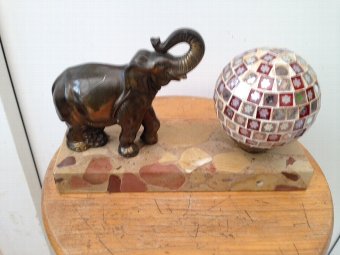We present this Art Deco bronze sculpture with a 20th century marble base signed Juan de Avalos y Taborda.
The base is rectangular of a beautiful Alicante red marble from Spain, brick red in color with light veins of white and gray tones.
The bronze sculpture in splendid light and dark aqua green patina, depicting a naked girl.
The young woman is seated with her legs together, her right arm caressing her feet and the left arm under her breast supports the sheet in the back which lies beneath her.
The neck is lowered and facing the observer, the hair falls behind the model revealing a graceful look that hints at a smile
The beautiful aqua green patina with light-dark games makes bronze seem almost stone, conveying elegance and beauty, soft as a woman's skin.
The skill of the Spanish sculptor is also noted in the physiognomy of the body: the legs, arms, hands, feet and back convey beauty and eroticism.
A work of the most important Spanish sculpture of the twentieth century, with a radiant marble base.
Delivery in Portugal, France, Italy, Germany, Belgium, the Netherlands, Switzerland, Austria included in the price.
Take a look at our social media profiles to read customer reviews and view our shipping packaging
Nicolò Di Giuseppe
Whats App +34 665372671
Antica Roma Anticuario
anticaromatoledo@gmail.com
Instagram: anticaromatoledo
Juan de Ávalos y Taborda (Mérida, 21 October 1911 - Madrid, 6 July 2006) was a Spanish sculptor.
His career has been associated with the sculptures of the Valle de los Caídos, considered the most important Spanish sculptor of the twentieth century.
He began to show great talent for drawing at the age of six, receiving drawing lessons from Juan Carmona, parish priest of the Church of Santa Eulalia.
At the age of eight, the family moved to Madrid. He studied at the Collegio dei Mercedarios, at the same time he went to the School of Arts and Crafts. As a child he liked classical sculpture, making sketches at the Casón del Buen Retiro (then home to the National Museum of Artistic Reproductions), and at José Zorrilla's Don Juan Tenorio, for which he made several sketches.
Although his family wanted him to go to university, starting as an apprentice for various wood sculptors and, at the age of fourteen, he entered the Real Academia de Bellas Artes de San Fernando.
In 1933, at 22, he achieved a place in the University of Seville, highlighting the Mérida Theater. He met Miguel de Unamuno at the Medea premiere. A year later he was appointed Deputy Director of the Archaeological Museum of Mérida.
In 1936 he enlisted in the army, but in 1938 he fell seriously injured in Jaén. In the same year he married Soledad Carballo Nuñez in Pontevedra and had two children: Juan and Luis.
San Giovanni in the Valle de los Caídos.
After the war, he opened a studio in Madrid, but in 1940 he received a complaint because he considered himself a republican collaborator. Ávalos continued his normal activity, participating in the National Fine Arts Exhibition.
In 1945 he received a public tribute to the Municipal Chamber of Porto, which was followed by several commissions in Lisbon, so he decided to set up his studio there. He will participate in exhibitions in Buenos Aires and Rio de Janeiro.
In 1950, a friend recommended him for the realization of the sculptures of the Competition of the Basilica of Santa Cruz della Valle de los Caídos.
Despite what has traditionally been said, ties never existed between the sculptor and Francisco Franco. During the Expo of 1950, Caudillo, visiting the exhibition, stopped in front of the statue of Ávalos said: This is the great sculptor who needs Spain.
They met at the Royal Palace of El Pardo, on the advice of Blas Pérez González, minister of the interior. There, the sculptor proposed a fundamentally religious theme, avoiding any suggestions.
About his aesthetics it has been written that he is "appreciated as one of the Spanish sculptors who showed a greater passion for the human body" 3, as observed in the bodies of the well-known mausoleum of Teruel lovers, or in the christs and Pieces off the chisel . He commented with the teacher Joaquín Rodrigo that the two were hand workers, the first who aesthetically tapped the piano keyboard and the second who tapped the stone until the job was done well.
In 1976, coinciding with the bicentennial of the Independence of the United States, Spain gave that country an equestrian statue of Galvez, the work of Juan de Ávalos, which was placed on Virginia Avenue in Washington, Washington DC. The statue is located in the Bernardo de Galvez memorial park, near the aforementioned avenue.
Works by Juan de Ávalos are exhibited in Santa Cruz de Tenerife, Teruel, Barbastro, Zaragoza, Puerto Rico, León, Oviedo, Guayaquil (Sacred Heart), Havana (Tribute to Cuba), Dominican Republic (Sculture Plaza de la Bandera), among other places. In one of the squares of Esquivias (Toledo) there is the monument dedicated to the cervantist Luis Astrana Marín; and also a gigantic statue of Cervantes. The statue dedicated to Rocío Jurado in his hometown. In Benidorm (Alicante) it is possible to see the monument to the fallen sailors and in the church of Mondragón a Cristo. In Burgos are preserved the equestrian statue of Count Diego Porcelos (founder of the city) and the monument to the armed forces. The city of Úbeda exposes two lions in the square of Vázquez de Molina, in front of the homonymous palace. In the Cathedral of Madrid a lying Christ is guarded because of his hand.
Antiques.co.uk Ref: TM298YMB
- Maker/Artist:
- Juan De Avalos (1911-2006)
- Width (cm):
- 19
- Height (cm):
- 18
- Depth (cm):
- 9
Here on antiques co uk we love antiques and specialise in selling antiques. Even though this item was for sale and is now sold or otherwise now unavailable we have many more items for sale including vintage antiques, silver, tables, watches, jewellery and much more for your interiors and home.
Search all the antiques currently for sale on www.antiques co uk. Or why not consider selling your antiques and making sales more easily with us!


![French Art Deco Tambourine Dancer, Signed Fayral.]() £535.00
£535.00![J DAUVERGNE BIRDS OF PARADISE ART DECO]() £1250.00
£1250.00![MUSSOLINI. BRONZE & MARBLE ART DECO]() £695.00
£695.00![Art-deco 25cm by 16cm by 5cm small side table lamp with an elephant standing on a marble base next to a multi-mirrored ball lamp shade]() £285.00
£285.00









